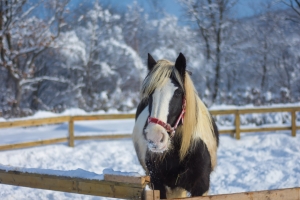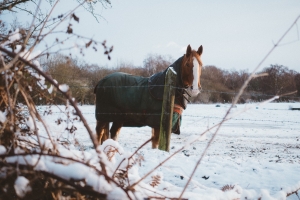By Dr. Allison Hartman
Let’s say it’s a balmy 16 degrees outside and you’re dressed in every article of arctic clothing Mountain Horse has to offer. You find yourself looking at your horse, stuck outside in this miserable cold, wondering if he needs a few layers of arctic gear to match yours. Sounds familiar right?
The Truth is Your Horse Probably Doesn’t Need a Blanket
 Here’s the deal. If your horse has grown a thick, fluffy winter coat of his own, has a body condition score greater than 5/9, has plenty of access to hay and thawed water and can get out of the wind and any precipitation, he most likely doesn’t need a winter blanket. (The exception to that would be if he’s in moderate to heavy work multiple days a week and ends up wet and sweaty after each ride, at which point we should talk about proper times to clip your horse. Consider that a later blog topic!).
Here’s the deal. If your horse has grown a thick, fluffy winter coat of his own, has a body condition score greater than 5/9, has plenty of access to hay and thawed water and can get out of the wind and any precipitation, he most likely doesn’t need a winter blanket. (The exception to that would be if he’s in moderate to heavy work multiple days a week and ends up wet and sweaty after each ride, at which point we should talk about proper times to clip your horse. Consider that a later blog topic!).
If left au naturale, healthy horses have a phenomenal ability to grow a winter coat that insulates them far better than any coat we could possibly provide. Their natural coat is designed to trap air against their body creating an insulating layer of warm air between their skin and the environment. Most of the time, this air barrier is sufficient to keep horses warm and cozy into the lowest temperatures our country has to offer. (Trust me – my old mare and I have done the leg work back in Minnesota!).
When a horse is blanketed, their hair becomes compressed. This compression compromises their ability to trap air between their skin and the external environment. As such, when blanketed with too thin a blanket for the environmental conditions, our good intentions can make the horse colder! If your horse is hanging out for the winter in minimal work with a fluffy coat, healthy weight and plenty of access to hay, water and shelter, he doesn’t need a blanket.
Situations Where Your Horse Would Need a Blanket
Situations that compromise that insulating layer of air include significant precipitation that accumulates and melts on the horse’s back, high winds, high humidity, and improper blanketing. Below is a list of equine conditions that would justify blanketing:
- A body condition score of 4/9 or below. Skinny horses have fewer energy reserves and thus may retain more body condition through the winter if blanketed sufficiently for the weather.
- Horses with no winter coat. Let’s say your horse just moved from Florida, or has been in a training program that’s either purposely limited the growth of his winter coat or removed his winter coat via clipping. (Or he’s a Thoroughbred). These horses would absolutely appreciate a blanket, and a thick one at that during super cold snaps!
- Horses in significant training programs. While these horses usually have minimal coats as mentioned above, horses in significant, routine work also have a diminished ability to thermoregulate their body temperatures.
- Sick horses. Just like you or I, when a horse is sick, their ability to thermoregulate their body temperature in response to external environmental conditions is often compromised.
- Foals and Geriatric horses may also require blanketing depending on the weather conditions.
- Sedated horses tend to sweat as part of a normal response to the types of sedatives most commonly used. While these horses don’t require long term blanketing, they may require a cooler or other moisture wicking attire to remove the sweat from their skin in a prompt fashion as they recover over the next few hours, especially on cold days.
What Kind of Blanket Should You Buy?
 If you’re going to blanket your horse, it’s important to mention that there are two types of blankets: stable and turnout. Stable blankets are made to be worn indoors – they lack the rigidity of turnout blankets and usually aren’t waterproof. Turnout blankets are far more resistant to tears and should always be waterproof. If you’re limited in the diversity of your horse’s wardrobe, I would highly recommend investing in a good turnout blanket.
If you’re going to blanket your horse, it’s important to mention that there are two types of blankets: stable and turnout. Stable blankets are made to be worn indoors – they lack the rigidity of turnout blankets and usually aren’t waterproof. Turnout blankets are far more resistant to tears and should always be waterproof. If you’re limited in the diversity of your horse’s wardrobe, I would highly recommend investing in a good turnout blanket.
What weight you ask?? Good question!
There are three weights of blankets, each corresponding to the amount of “fill” or insulation. Light weight blankets usually have no insulation and instead merely provide a water and wind-proof barrier to the external environment. Medium weight blankets have 100-200 grams of fill, while heavy weight blankets usually have over 300 grams of fill.
Below is a table of environmental conditions and corresponding weights. Keep in mind that higher humidity, lower wind chills, higher precipitation and work load will increase the corresponding temperatures at which you would chose a certain weight of blanket. Every horse is different, so finding the right combination of blankets for your particular horse may be a bit of experiment. Please don’t hesitate to ask Drs. Baird or Hartman for a personalized plan for blanketing your horse.
| Blanketing Guidelines | ||
| Recommended Weight | Average Temperature Cutoff | |
| Clipped horse or minimal coat | Horse with a thick, healthy coat | |
| Lightweight Sheet | 60 degrees | Below 35 and raining |
| Midweight Blanket | 45 degrees | 25 degrees |
| Heavy Blanket | Below 30 degrees | Below 0 degrees |




